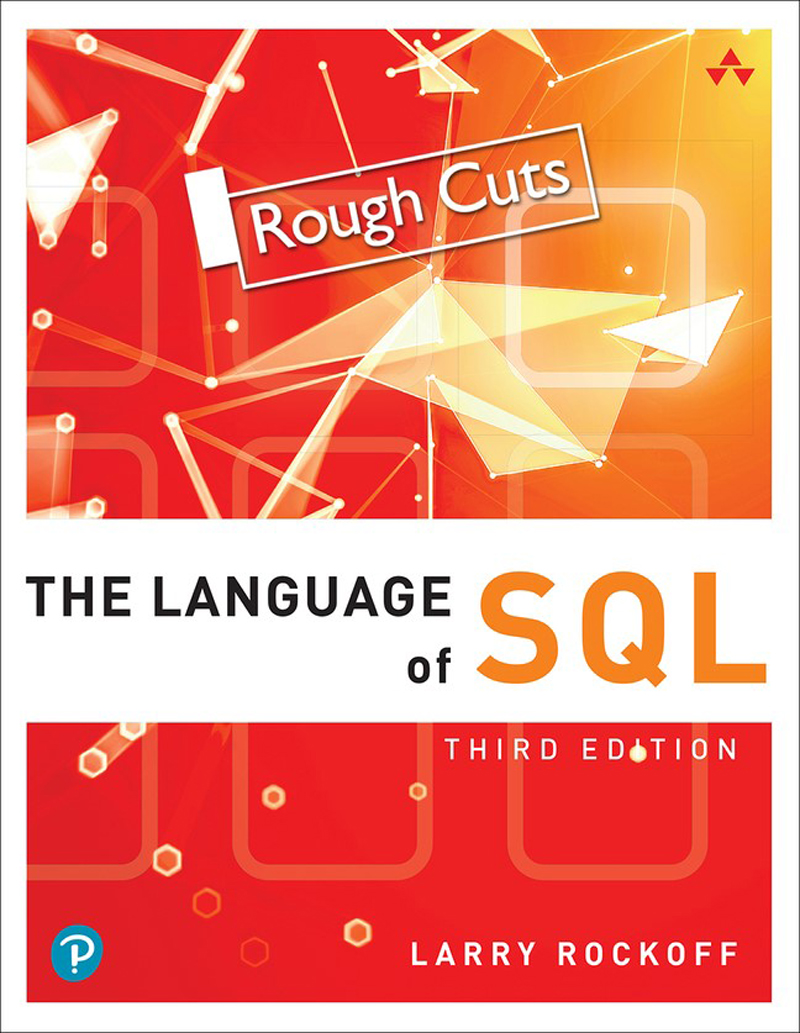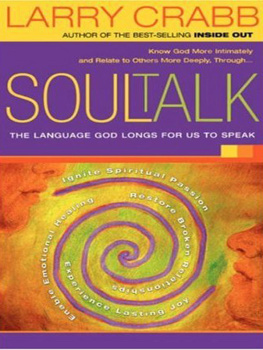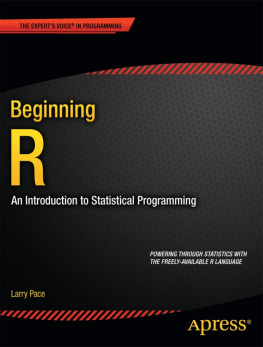Larry Rockoff - The Language of SQL, 3rd Edition
Here you can read online Larry Rockoff - The Language of SQL, 3rd Edition full text of the book (entire story) in english for free. Download pdf and epub, get meaning, cover and reviews about this ebook. year: 2021, publisher: Addison-Wesley Professional, genre: Home and family. Description of the work, (preface) as well as reviews are available. Best literature library LitArk.com created for fans of good reading and offers a wide selection of genres:
Romance novel
Science fiction
Adventure
Detective
Science
History
Home and family
Prose
Art
Politics
Computer
Non-fiction
Religion
Business
Children
Humor
Choose a favorite category and find really read worthwhile books. Enjoy immersion in the world of imagination, feel the emotions of the characters or learn something new for yourself, make an fascinating discovery.

- Book:The Language of SQL, 3rd Edition
- Author:
- Publisher:Addison-Wesley Professional
- Genre:
- Year:2021
- Rating:5 / 5
- Favourites:Add to favourites
- Your mark:
- 100
- 1
- 2
- 3
- 4
- 5
The Language of SQL, 3rd Edition: summary, description and annotation
We offer to read an annotation, description, summary or preface (depends on what the author of the book "The Language of SQL, 3rd Edition" wrote himself). If you haven't found the necessary information about the book — write in the comments, we will try to find it.
The Language of SQL, 3rd Edition — read online for free the complete book (whole text) full work
Below is the text of the book, divided by pages. System saving the place of the last page read, allows you to conveniently read the book "The Language of SQL, 3rd Edition" online for free, without having to search again every time where you left off. Put a bookmark, and you can go to the page where you finished reading at any time.
Font size:
Interval:
Bookmark:

Larry Rockoff

Larry Rockoff has been involved with SQL and business intelligence development for many years. His main area of interest is in using reporting tools to explore and analyze data in complex databases. He holds an MBA from the University of Chicago and a BFA from the University of Illinois.
Besides writing about SQL, he has also published books on Microsoft Excel and Access. His latest editions of those texts are Exploring Data with Excel 2019 and Exploring Data with Access 2019.
He also maintains a website which features book reviews on technology topics, as well as broader issues regarding technology and society:
 larryrockoff.com
larryrockoff.com
Please feel free to visit that site to contact the author with any comments or questions.
SQL, or Structured Query Language, is the primary language used to communicate with relational databases. The goal of this book is to serve as a useful introductory guide to this essential language.
In an alternate universe, the title of this book might have been The Logic of SQL. This is because, like all computer languages, the language of SQL has much more to do with cold hard logic than with English vocabulary. Nevertheless, the word language has been retained in the title for a number of reasons. First, a certain language-based syntax in SQL distinguishes it from other computer languages. Unlike other languages, SQL employs many ordinary words, such as WHERE and FROM, as keywords in its syntax.
In the spirit of the language embedded in SQL, weve adopted an emphasis on language in our sequence of topics. With this book, youll learn SQL as you would learn English. SQL keywords are presented in a logical progression, from simple to more complex. In essence, this is an attempt to deal with language and logic simultaneously.
To learn any language, one must begin by hearing and remembering the actual words that form the basis of its utterance. At the same time, those words have a certain meaning that must be understood. In the case of SQL, the meaning has a great deal to do with logic.
One final reason for persisting with the title The Language of SQL rather than The Logic of SQL is that it simply sounds better. While there can be few literary pretensions in this type of book, the hope is that the presence of the word language in the title will generate some additional enthusiasm for a subject that is, after all, quite interesting.
Even if youre not yet familiar with SQL, suffice it to say that it is a complex language with many components and features. In this book, well focus on one main topic:
 How to use SQL to retrieve data from a database
How to use SQL to retrieve data from a database
To a lesser extent, we will also cover:
 How to update data in a database
How to update data in a database
 How to build and maintain databases
How to build and maintain databases
 How to design relational databases
How to design relational databases
 Strategies for displaying data after it has been retrieved
Strategies for displaying data after it has been retrieved
A number of features make this book unique among introductory SQL books:
 You will not be required to download software or sit with a computer as you read the text.
You will not be required to download software or sit with a computer as you read the text.
Our intent is to provide examples of SQL usage that can be understood simply by reading the book. The text includes small data samples that allow you to clearly see how SQL statements work.
 A language-based approach is employed to enable you to learn SQL as you would learn English.
A language-based approach is employed to enable you to learn SQL as you would learn English.
Topics are organized in an intuitive and logical sequence. SQL keywords are introduced one at a time, allowing you to build on your prior understanding as you encounter new words and concepts.
 This book covers the syntax of three widely used databases: Microsoft SQL Server, MySQL, and Oracle.
This book covers the syntax of three widely used databases: Microsoft SQL Server, MySQL, and Oracle.
If there are any differences between these databases, the Microsoft SQL Server syntax is shown in the main text. Special Database Differences sidebars show and explain any variations in the syntax for MySQL or Oracle.
 An emphasis is given to relevant aspects of SQL for retrieving data.
An emphasis is given to relevant aspects of SQL for retrieving data.
This approach is useful for those who need only to use SQL in conjunction with a reporting tool. In our final chapter, well move beyond pure SQL to cover strategies for displaying data after it has been retrieved, including ideas on how to use crosstab reports and pivot tables. In the real world, these types of tools can substantially lessen the burden on the SQL developer and provide greater flexibility for the end user.
Note
Visit our website and register this book at informit.com/register for convenient access to downloads, updates, or errata that may be available for this book.
Here are some of the new features of this third edition:
 Coverage of the latest database versions
Coverage of the latest database versions
All syntax and examples have been taken from the latest versions of the three main databases covered in this book: Microsoft SQL Server 2019, MySQL 8.0, and Oracle 18c.
 Expanded coverage of common analytical tasks
Expanded coverage of common analytical tasks
The third edition adds new sidebars on common analytical tasks. While not essential to learning the language, these topics cover useful calculations and procedures such as calculating a median and creating fiscal calendars.
 Expanded coverage of functions
Expanded coverage of functions
This edition adds a number of new date/time and numeric function in , we have expanded our coverage of rank functions and partitions by adding material on analytic functions, a useful topic for the business analyst.
 Excel Pivot Charts
Excel Pivot Charts
In , we extend our discussion of Excel pivot tables to also include charts and pivot charts. This is useful for the analyst who wants to extend the power of SQL to visually explore data.
 New datasets
New datasets
As in the prior editions, each chapter has its own small set of data to use as examples. These datasets are revised in this edition to be more contemporary.
 Improved Supplemental Materials
Improved Supplemental Materials
The supplemental materials on the companion website have been reorganized with setup scripts and SQL statements in separate files. These files are now organized by both table and chapter, making it easier for the reader to find any desired SQL statement. In addition, weve also added an Excel file with the source data seen in .
Font size:
Interval:
Bookmark:
Similar books «The Language of SQL, 3rd Edition»
Look at similar books to The Language of SQL, 3rd Edition. We have selected literature similar in name and meaning in the hope of providing readers with more options to find new, interesting, not yet read works.
Discussion, reviews of the book The Language of SQL, 3rd Edition and just readers' own opinions. Leave your comments, write what you think about the work, its meaning or the main characters. Specify what exactly you liked and what you didn't like, and why you think so.








